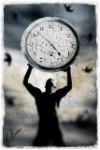12-26-2009, 11:33 PM
0
http://www.telegraph.co.uk/earth/wildlif...routs.html
Quote:Staff at the Great Yarmouth Sea Life Centre in Norfolk give turtles a seasonal treat of brussel sprouts at Christmas which provide a healthy dose of vitamins, minerals and fibre.
However, the turtles, like humans, are prone to heavy bouts of flatulence after eating the vegetables.
Last year a turtle at a Sealife Centre triggered overflow alarms in the middle of the night after the splashes from gassy bubbles hit overflow sensors.
Now the Yarmouth turtle tank -12 feet in depth and width holding 250,000 litres of water along with George the 3ft long green turtle - has been partially emptied for the festive season.
Thousands of litres have been removed to lower the water by a six inches and keep the sensitive alarms clear.
Displays Supervisor Christine Pitcher said: ''Last time an aquariist had to dash to the centre in the middle of the night, so we're not going to take any chances.
''Sprouts are really healthy for green turtles.
''The high levels of calcium in them are great for their shells, the fibre is good for their digestion and they also contain lots of beneficial Vitamin C, sulphur and potassium.''
Senior Marine Biologist Darren Gook added: ''We like to treat him to different foods and seeing as it's Christmas we thought brussel sprouts would be good.
''I haven't noticed too many bubbles coming from George yet but hopefully now the water levels have been adjusted flatulence won't cause problems.''
Green turtles are mainly herbivores who feed on marine grasses and algae and are found in coastal regions of the Atlantic, Pacific and Indian Oceans.
They are the largest turtles in the world and can grow up to one and a half metres (five ft) in length, weigh an incredible 400 kilos (63 stone) and live for up to 80 years.
Poaching and destruction of habitat has led to a decline in numbers and the species is now endangered, with a critically endangered population in the Mediterranean.
The eight-year-old resident male at Great Yarmouth Sea Life centre measures a metre and will reach maturity for another 20 years.






















 farting turtles!
farting turtles! ![[Image: PancakeBunny.jpg]](http://www.twitchinkitten.com/myphotos/PancakeBunny.jpg)










![[Image: alcatraz-prison-picture2-1.jpg]](http://i17.photobucket.com/albums/b78/lktraz/Sigs%20and%20Avs/alcatraz-prison-picture2-1.jpg)
![[Image: dont_care_offended.gif]](http://i17.photobucket.com/albums/b78/lktraz/Sigs%20and%20Avs/2012%20Bumper%20stickers/dont_care_offended.gif)








![[Image: rhubarb.gif]](http://www.twitchinkitten.com/cmne/albums/userpics/10001/rhubarb.gif)



![[Image: timehome2-1.jpg]](http://i18.photobucket.com/albums/b113/BarEdul/timehome2-1.jpg)